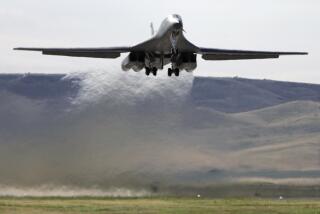Expected to Take Two Years to Fix : Radar Deficiencies Make B-1 Vulnerable to Soviets
The B-1 bomber could be shot down by the Soviet’s most advanced surface-to-air missiles because of deficiencies in its electronic radar jamming system, built in New York by the Eaton Corp., Air Force officials have disclosed.
The jammer’s shortcomings mean that the bomber cannot safely fly over certain Soviet anti-aircraft sites, as it was expected to do, apparently limiting its capability to attack some highly defended Soviet targets.
Although Air Force officials consider the defects in the Eaton system serious, they expect the problems to be solved within two years. Lt. Gen. William Thurman, commander of the Air Force’s research and procurement agency for aircraft, said the fixes will not bust the B-1’s $20.5-billion budget, which would trigger a political firestorm in Congress.
The technical flaws in the jamming system and a handful of other nagging deficiencies in the nuclear bomber already have given rise to a controversy that has tarnished the reputation of the B-1, formally known as the B-1B.
In the last six months, revelations about leaky fuel tanks, a flawed navigational radar and a balky flight-control system have fueled allegations by critics that the B-1 is a technological dud.
Thurman, as well as executives at Rockwell International, the prime contractor on the B-1, reply that the B-1 remains a well-managed weapons program. They note that the giant bomber is currently on operational alert status at Strategic Air Command bases and is ready to perform its nuclear bombing mission at a moment’s notice.
The deficiencies, they insist, are mostly normal types of problems that surface in any complex weapons system and are not fatal flaws that would impair the long-term usefulness of the weapon, as some critics of the B-1 have alleged.
“We haven’t found any technical hurdles we can’t solve,” the Air Force’s Thurman said in a telephone interview. “We think the B-1 is going to be a model program. It is more reliable than we asked for in the contract.”
But, for the time being, the Air Force has a major glitch in the radar jammer to fix.
Air Force officials have asked Congress for $469 million to extend B-1 flight testing at Edwards Air Force Base in California to correct the jammer’s problems. Eaton is expected to exceed its contract target of $2.4 billion for producing the system and part of the $469 million will cover that overrun, Thurman said. Under Eaton’s “fixed price” contract, the government initially absorbs 80% of the additional cost over the target price.
In addition, because Eaton is behind in its schedule for delivering the jamming systems, the government is withholding $128 million in payments to the company.
Eaton officials said they would have no comment on any statements by the Air Force.
Defense Against Soviet Detection
The Eaton defensive avionics system, also known by its military designation of the AN/ALQ-161, is supposed to be one of the B-1’s most potent defenses against detection and targeting by Soviet anti-aircraft missiles and jet interceptors. Unlike the United States, the Soviet Union has a massive continental air defense system designed to shoot down intruding nuclear bombers.
But the Eaton system is not working to its full capability and cannot defend the aircraft against all the threats it would encounter, said Thurman, who is commander of the Air Force’s Aeronautical Systems Division at Wright-Patterson Air Force Base in Dayton, Ohio.
“The capability we don’t have is to fly over some of their newer (anti-aircraft) systems and actually put them down (incapacitate them) with electronics,” Thurman said. “For those systems, we just avoid them.”
The interim solution to flying around the Soviet surface-to-air missile sites, however, creates nettlesome limitations in planning a strategic bombing mission. The Soviets have obviously placed their SAM sites in key locations to defend their most valuable national assets.
Limitation Called Serious
Strategic experts on the Armed Services committees in Congress say that the limitation is serious because the Air Force was expecting the B-1 to expand the number of Soviet targets that would be attacked by bombers rather than nuclear missiles. Nuclear bombs dropped by an aircraft are far more accurate than intercontinental missiles and the United States has far more of them.
Gen. Bennie Davis, the retired chief of the Strategic Air Command and a traditional supporter of the B-1, observed, “You would like to be able to combat every threat, but that’s not realistic. It is a new system and it is going to have problems. Now, some of the problems are more serious than anticipated.”
In fact, Air Force officials have known for some time that Eaton was encountering trouble with the highly sophisticated AN/ALQ-161.
Lt. Gen. Thomas H. McMullen, the recently retired commander of the Aeronautical Systems Division, said Eaton first began experiencing trouble with producing the system two years ago.
“Eaton initially had some problems and didn’t recognize them,” McMullen said. “This really comes to light publicly now, but it is not something that should surprise people.”
Direct Air Force Contract
In an effort to save money, the Air Force put Eaton under a direct Air Force contract, which means that Rockwell is not responsible for Eaton’s problems. Many experts now think that that was a serious error, because Eaton and other associate contractors are having far more problems, especially in the area of integrating individual systems, than the companies working directly under Rockwell. On its part of the program, Rockwell is ahead of schedule.
The principal technical problem with the jammer is that it tends to interfere with itself. In other words, its transmitter tends to jam its own antenna. The problem did not crop up until last year when the full system was tested for the first time.
The solution will be largely accomplished through software changes. Even so, some congressional staff members worry that the Air Force is being too optimistic in its outlook, especially since the $469 million is primarily going to be spent on flight testing. They worry that the tests will only show what the problem is and that more money will be needed to correct it.
Additional $600 Million Asked
In addition, the Air Force wants $131 million in fiscal 1988 to begin work on improvements and modifications to the jamming system. That puts the total request for additional B-1 funds at $600 million.
“This is going to be the No. 1 issue when we have our hearings on the Air Force budget,” said Rep. Norman D. Dicks (D-Wash.), a member of the House Appropriations subcommittee on defense. “The jammer is critical to the B-1’s ability to penetrate.”
The Air Force request for additional B-1 funds is not expected to take the program over the cap that President Reagan set when he launched the program in 1981. The cap was $20.5 billion when Reagan announced it but has been pushed by inflation up to $28.3 billion--about $283 million per aircraft.
Last year, Congress pulled about $1 billion of spare funds out of the B-1 program over opposition from the Air Force, which felt it needed the extra funds as a management reserve. Now, it must go back to Congress and air its problems in order to get the money back.
More to Read
Sign up for Essential California
The most important California stories and recommendations in your inbox every morning.
You may occasionally receive promotional content from the Los Angeles Times.











